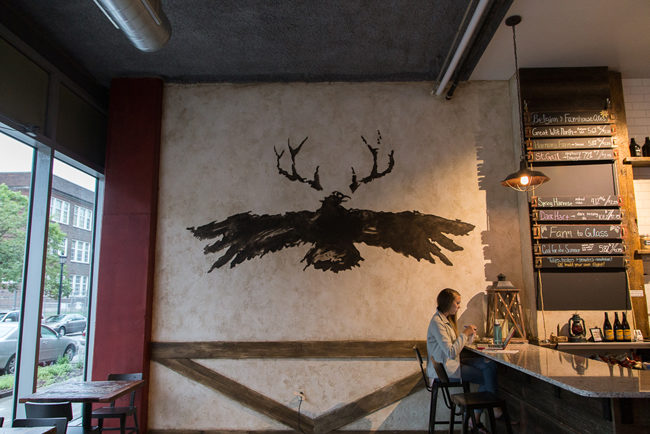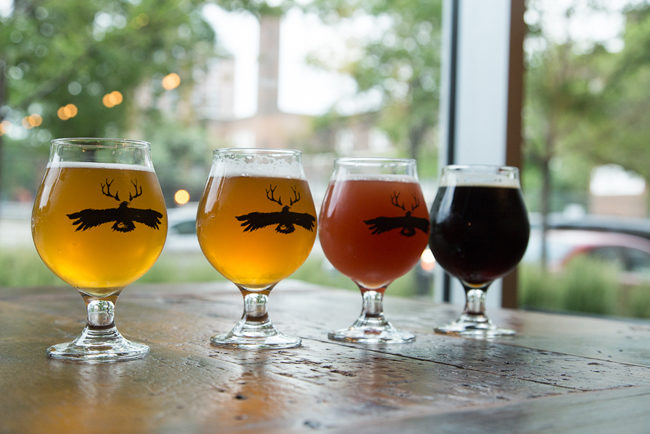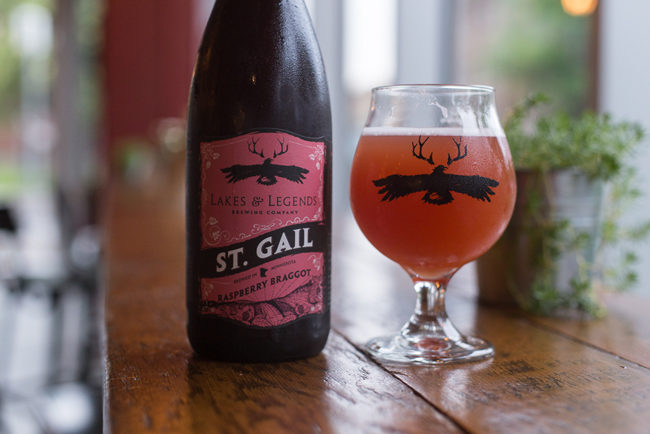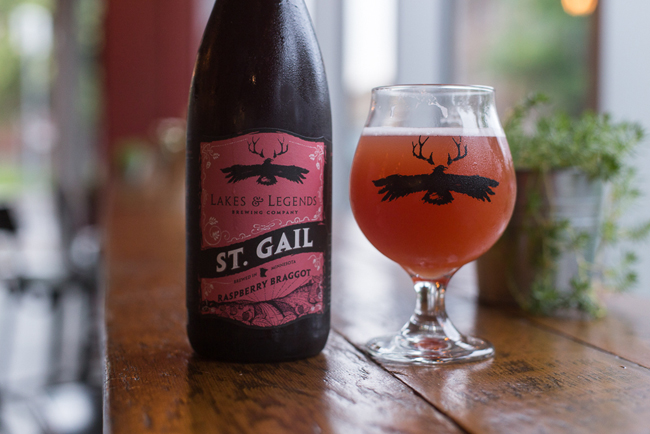
It is not often that a Minnesota brewery launches with the vision of creating Belgian-style beers. Amid the expanding landscape of over 100 breweries in the state, only a handful classify themselves as creators of Belgian beer. Two are in the Twin Cities: Boom Island Brewing and Harriet Brewing. The former is incredibly precise in its techniques and styles, while the latter has adopted a broader scope in presenting beers that have Belgian-inspired identities. Blacklist Artisan Ales and Borealis Fermentery on the North Shore are known for similar specialties.
Lakes & Legends Brewing Company opened in November, between Loring Park and downtown, touting the “farmhouse” designation. The term comes from the Belgian and French farmhouse style of beer, which is essentially another term for saison, give or take a few technical points, or the interpretation of the brewer. It’s location makes it the closest brewery to downtown hotels, the Convention Center and Nicollet Mall, with Town Hall in Seven Corners and the growing group of breweries in the North Loop not much farther away. Located on the first floor of Minneapolis’ newest luxury rental high-rise, the taproom couldn’t be further from the bucolic roots of farmhouse beer.
Head brewer Andrew Dimery comes to Minnesota from Louisville’s Bluegrass Brewing Company, a two-location brewpub that offers a mix of German, British, and American styles of beer. Owners and brothers-in-law Ethan Applen and Derrick Taylor have backgrounds in marketing and media. Applen moved from the West Coast to join Taylor to open Lakes & Legends, but construction began only after the pair considered several other hotbed beer cities.

The taproom’s decor is a mix — artificial turf and lawn games in the seating area to farmhouse-chic behind the bar with a wall of white subway tile and dark wood. In the cooler months, it offers ample space to enjoy activities like bean bags that would otherwise be limited to the summer. Recently, some patio seating was added, and there is a food truck on weekends. A few snacks are available for purchase at the bar, too.
For those who frequent other taprooms, it is impossible to ignore the prices. Tulips (12 ounces) are the largest size offered, regardless of the alcohol content of the beer, and they cost $6 to $7. All beers are available in 4-ounce tasting glasses, at $2.25 to $2.75, designed for building a custom flight or to be purchased individually. Furthermore, growler prices are out of sight at $20 to $24 for a half-gallon fill. Average prices at other taprooms are far lower, with many charging $5 to $6 for a 16- or 20-ounce pour, and $3 to $4 for a tulip.
Lakes & Legends does not offer any reasoning — such as organic or specialty ingredients, an extended aging processes, or higher alcohol content — to substantiate the cost. And the quality of their product certainly doesn’t answer the question. We found a few overarching issues in nearly every beer, and some were undrinkable.

The best of the bunch was Harmony Farm Saison (second from left), which is a good, if not basic, example of the style. Typical Belgian, yeast-derived flavors, like citrus and grass, are clear, and the finish is appropriately dry and lingering. The light to medium body is pleasant when combined with appropriate carbonation. If not for a slight sulfur on the nose, it would be a classic.
On the other hand, the Cool for the Summer Saison (left) doesn’t deliver on what its aroma promises. Excellent cucumber and yeast notes dominate the nose. On sipping, the mint quickly escalates beyond what the cucumber is able to temper. The beer is overwhelmingly sweet, and when combined with the herb, an unrelenting flavor of spearmint gum takes over. What’s more, there are none of the hallmark Belgian elements typical of the style. The combination of cucumber and mint would work much better in a beer with more salinity or minerality, like a Gose or even a Pilsner.
The inappropriate level of sweetness is indicative of significant brewing issues. Several factors are at play in ensuring that a beer is not too sweet, but ultimately it hangs on how much of the sugar in the wort is converted to alcohol by the yeast, and how much is left behind. The degree of sugar fermentation is known as attenuation. Dry and crisp beers, regardless of hop bitterness, are highly attenuated, while sweeter beers are somewhat less so.
Attenuation is the domain of the Belgian brewer. The ones in Belgium. This is their forte, no doubt, in the way that British brewers have mastered cask ales and Germans are authorities on clean lagering. The famous breweries of Belgium, including the monasteries that produce Trappist beer, are in control of their yeast strains, and never — never — rush a beer or in any way allow residual sweetness to be present unintentionally.

Even sweeter than the Cool for the Summer is the St. Gail raspberry braggot. A braggot, though, is a combination of beer and mead, so the allowance for sweetness in the case of this style is greater. By definition, braggots should demonstrate qualities of both beer and mead, meaning that both the base beer style and the honey addition should be perceptible. The St. Gail has an aroma not unlike that of a pint of fresh raspberries greets the nose, but is nearly lost in the mouth. Sugar takes over, leaving little else on the tongue. In this case there isn’t any evidence of the beer, and even the sugar doesn’t taste much like honey.
Two other tastes were even more befuddling. First was the Dark Hart dark ale (rightmost of four glasses in group of four above), which was described using terms one would expect from a Abbey-style quadrupel: high alcohol, caramel, and fruit. However, it possessed very low aroma, even on warming, and what eventually was noted was a strange fermented berry and chocolate smell. We were doubtful that it reached its target 10.1 percent alcohol by volume. It mysteriously tasted like a lifeless Schwarzbier, as though it were lagered.
Finally, the Bitter Farmhand IPA was the worst of the bunch, with no redeeming qualities. The glass smelled distinctly like canned green beans from a lunchroom cafeteria with hints of grass fire. An unpleasant green-bean taste was enough to turn the stomach. Additionally, it had zero hop character, and no distinct malt notes could be sifted out through the vegetal taste.
Lakes & Legends suffers from a lack of identity. The taproom doesn’t fit in with its surroundings or with the styles of beer presented. Even from one end of the dining room to the other there is little continuity. There seems to be a misunderstanding about what Belgian-inspired beer should taste like, and possibly about how it is made, as they claim to be inspired by “the experimental tradition of Trappist beer,” which is erroneous: Trappist beer is arguably the most heritage-based and consistent beer on the planet.
The origins of the place are uncanny in their similarity to Nutmeg Brewhouse — brothers or close business partners who hire a brewer from out of state to capitalize on a trend, have little by way of Minnesota identity, and expect to rely on built-in customers (in this case, a high-rise; in the case of Nutmeg, a restaurant) to succeed. But the lack of substance (in the form of quality beer) is a glaring problem.
Lakes and Legends Brewing Company, 1368 Lasalle Ave, Minneapolis, MN 55403; 612.999.6020


This is really expertly written and impressive. Well done.
It’s great that Heavy Table is taking a critical eye to new breweries and praising/calling them out appropriately. Five years ago, we were just excited to have new breweries and taprooms; now, they’re nearly ubiquitous, and it’s time to separate the wheat from the chaff. With limited time to visit breweries I don’t want to land on a dud, and your review has helped me avoid what sounds like a definite whiz-bang of a dud. Thank you.
But, wait! It sounds like there’s plenty of passion here…for making money and jumping on a trend with no real clue or expertise.
Belgian beer can be big, yes. They can have sweetness, yes. HOWEVER, if you do your homework as a brewer or consumer and go out and taste the best commercial ones (Duvel, Westmalle, Dupont, etc….) you know they’re balanced and finish dry NOT fat & sweet.
Thank you to the author for writing a discerning and honest opinion of a new brewery! This is badly needed in our burgeoning beer scene and will ensure that I come back to The Heavy Table to read more reviews.
Regarding beer sizing, there is at least one brewery tap room out there in Minneapolis who call out pint on their beer menus and then serve the beer in a glass that is a 14 once glass, thus short changing their paying customers 14% on each beer sold. The definition of a pint is always 16 fluid ounces.
This is deceiving to their customer base and causes ill will to people in the know.
I choose not to support such establishments.